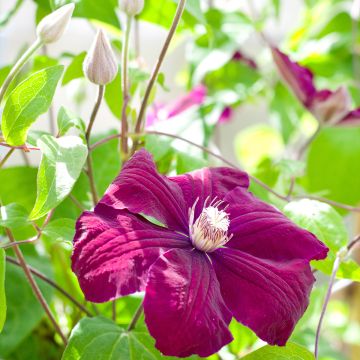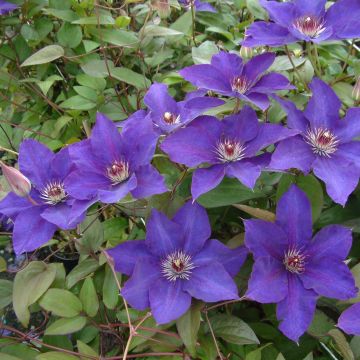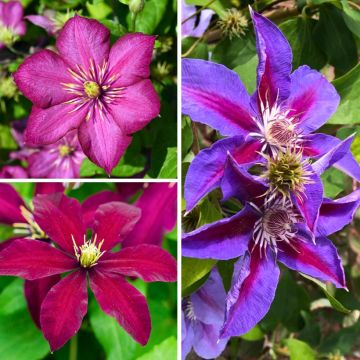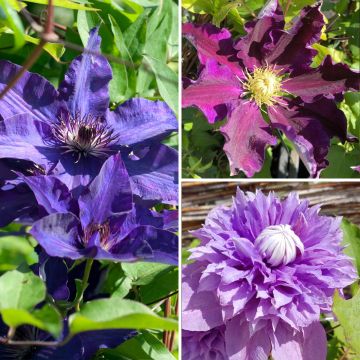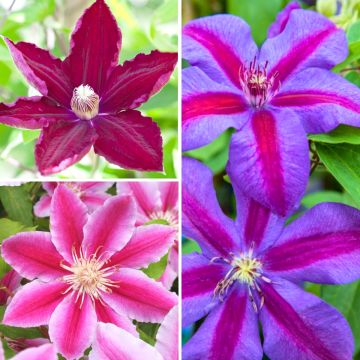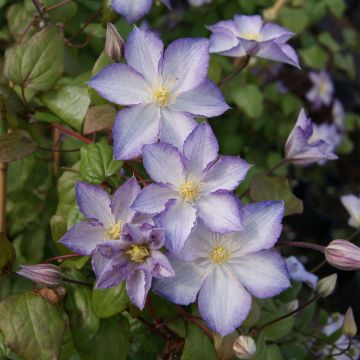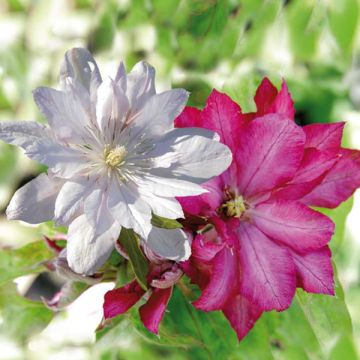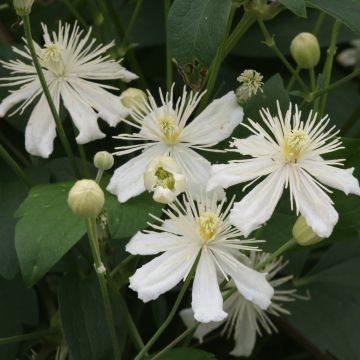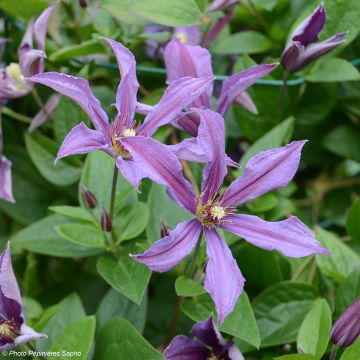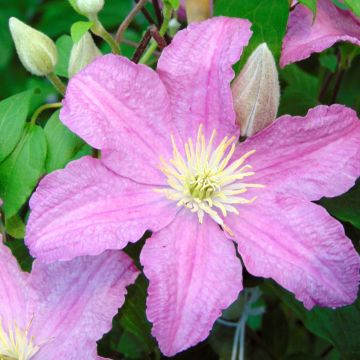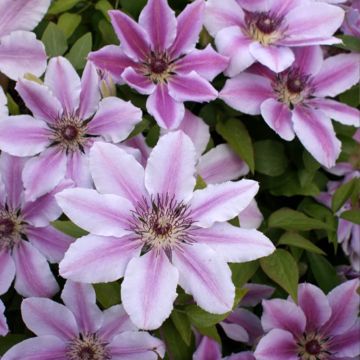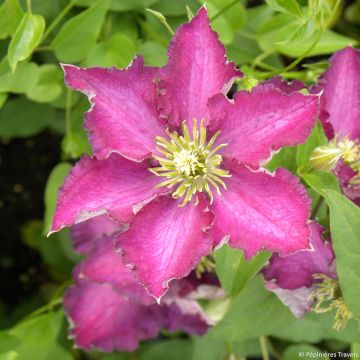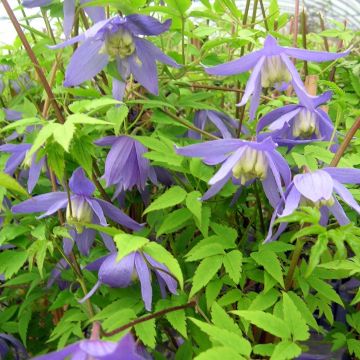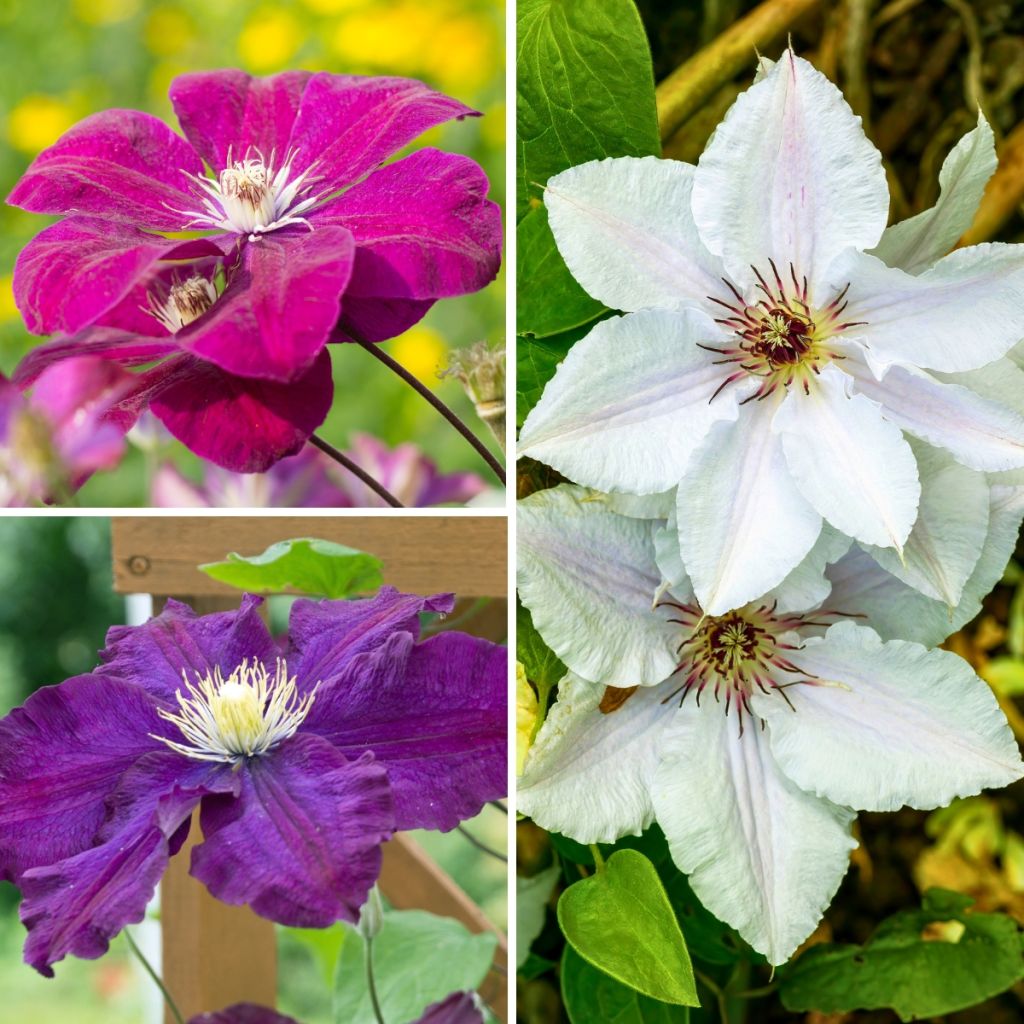

Clematis Three Sisters tricolour mix - Rouge Cardinal, The Vagabond and Snow Queen.
Clematis Three Sisters tricolour mix - Rouge Cardinal, The Vagabond and Snow Queen.
Clematis Mix Tricolor
Traveller's Joy, Old Man's Beard, Virgin's Bower
Special offer!
Receive a €20 voucher for any order over €90 (excluding delivery costs, credit notes, and plastic-free options)!
1- Add your favorite plants to your cart.
2- Once you have reached €90, confirm your order (you can even choose the delivery date!).
3- As soon as your order is shipped, you will receive an email containing your voucher code, valid for 3 months (90 days).
Your voucher is unique and can only be used once, for any order with a minimum value of €20, excluding delivery costs.
Can be combined with other current offers, non-divisible and non-refundable.
Home or relay delivery (depending on size and destination)
Schedule delivery date,
and select date in basket
This plant carries a 6 months recovery warranty
More information
We guarantee the quality of our plants for a full growing cycle, and will replace at our expense any plant that fails to recover under normal climatic and planting conditions.
Would this plant suit my garden?
Set up your Plantfit profile →
Description
Clematis Three Sisters tricolour is a collection of three varieties of clematis in the same pot, each offering a different flower colour. 'Rouge Cardinal' is a French creation, opening with a dark red colour that gradually lightens. 'The Vagabond' comes from England and produces large, very intense purple flowers. 'Snow Queen' originates from New Zealand and blooms with beautiful white stars, creating a magnificent contrast with its two sisters. They are compact varieties, reaching a height of 2m or 2.50m and provide flowers from May to September, or even October. The collection is ideal on a sunny balcony or terrace and does not need to be sheltered for winter, as all three are very hardy.
Clematis belongs to the family of Ranunculaceae, like columbines or anemones. They are found in Europe, the Himalayas, China, Australia and North and Central America. The genus includes more than 200 species, mostly climbing plants, compact or capable of reaching up to 8m in height in trees like Clematis montana, but also some non-climbing herbaceous plants, such as Clematis heracleifolia.
The most difficult thing is often to choose between the beautiful blooms available, Three Sisters will delight you with 3 superb varieties in different and complementary colours. The variety 'Rouge Cardinal', obtained in 1968, has 'Ville de Lyon' and 'Pourpre Mat' as its parents. From this crossbreeding comes a superb variety with dark red flowers measuring 10 to 12cm in diameter, enhanced by a beautiful crown of cream stamens with purple anthers. Flowering begins in June, with fairly dark red flowers reminiscent of precious velvet, and ends in September-October with flowers that gradually lighten. The flowering is followed by decorative silvery grey feathery seed heads that persist until winter. The smooth leaves are divided into 3 elliptical to lanceolate, dark green leaflets. This relatively compact clematis can reach a height of 2.50m, up to a maximum of 3m if left unrestricted.
The second plant in this composition, 'The Vagabond', was created in 1984 in England from a cross between the first one, 'Rouge Cardinal', and an unknown variety. It is more compact and does not exceed 2m in free form, which it compensates for with the size of its flowers: up to 18cm in diameter! Blooming from May to August in large stars, they display an intense purple colour with a central band of purple-violet to beautiful effect. The cream-yellow stamen centre is quite large and contrasts nicely with the petals. Its deciduous, oval, lanceolate, green, 10cm long leaves, are carried by twining stems that coil around their support using tendrils.
'Snow Queen', the third "sister", comes from far away, as it is a seedling of Clematis patens selected in 1958 by a New Zealand breeder. It produces a superb star-shaped flowering in May-June, sometimes reblooming in September. The large flowers, which can reach 16cm in diameter, are pure white, or occasionally subtly tinged with pink, with purple anthers in the stamen centre. With a vigour comparable to 'Rouge Cardinal', it reaches a width of 1.50m if left unrestricted, just like its sister. Its deciduous foliage consists of three-lobed, fairly dark green leaves.
These three sisters are very hardy (around -25°C) and appreciate the sun, provided that their base is protected. A moist humus-rich soil is suitable for them, without excessive moisture, and this original composition will flower throughout summer. A balcony or terrace is enough to enjoy their abundance.
Three Sisters is a beautiful combination of generous climbers that will enhance your terrace beautifully. If you have a conservatory, you can extend the flowering period by obtaining a Hardenbergia violacea in a pot, which will reward you with an abundance of small mauve-purple flowers from February to June, beautifully highlighted by its dark green evergreen foliage. If you want to plant your composition in the ground, you can create beautiful combinations with climbing roses if you have a fence to cover or a pergola to dress. Another idea is to let your clematis climb on shrubs or small trees. Their vegetation is light enough not to harm their living support and it will add a subtle touch to your plant decor.
Report an error about the product description
Plant habit
Flowering
Foliage
Safety measures
Botanical data
Clematis
Mix Tricolor
Ranunculaceae
Traveller's Joy, Old Man's Beard, Virgin's Bower
Cultivar or hybrid
atteintescutaneomuqueuses
Cette plante peut provoquer l'apparition de réactions cutanées indésirables, une atteinte des yeux, ou des difficultés respiratoires si elle est ingérée.
Ne la plantez pas là où de jeunes enfants peuvent évoluer. Evitez tout contact avec la peau: privilégiez l'emploi de gants pour la manipuler. En cas de contact, lavez-vous soigneusement les mains et rincez abondamment à l'eau la zone concernée. Lavez les vêtements entrés en contact. En cas de réaction cutanée, contactez votre médecin ou le centre antipoison le plus proche de chez vous. En cas d'atteinte étendue ou de difficultés respiratoires, appelez immédiatement le 15 ou le 112.Pensez à conserver l'étiquette de la plante, à la photographier ou à noter son nom, afin de faciliter le travail des professionnels de santé.
Davantage d'informations sur https://plantes-risque.info
Other Clematis Jackmanii
View all →Planting and care
This composition of clematis is intended to stay in a pot to enhance a terrace. In this case, after about 2 years, it will be a good idea to repot it in a larger pot or container, to allow the roots to develop well. Choose a pot that is deeper than wide so that it is suitable for the root system.
However, if you wish to plant your clematis in the garden, these plants like to have their heads in the sun and their feet in the shade. Plant them in a fertile, humus-rich, well-drained soil, shading the roots and the base of the stem with a flat tile, for example. Be careful, clematis can wilt in overly wet soil. After planting, cut back the stems of the clematis to approximately 30 cm from the base, above a nice pair of buds. During the first few weeks, water regularly. However, be careful not to let the water stagnate, as this can cause a fungus to develop at the collar. Mulch all clematis in February with garden compost or well-rotted manure, avoiding direct contact with the stems. Train the stems, without crushing them, until the plants cling to them themselves. Clematis also like to grow freely on neighbouring plants.
Slugs can attack clematis and devour the stems. Aphids and greenhouse whiteflies are also potential parasites of clematis.
Avoid fertilisers that are too high in nitrogen, as they would favour foliage at the expense of flowering. Instead, choose an organic fertiliser that is more concentrated in potash (the K in the N-P-K formula) than in nitrogen (the N).
Planting period
Intended location
Care
This item has not been reviewed yet - be the first to leave a review about it.
Similar products
Haven't found what you were looking for?
Hardiness is the lowest winter temperature a plant can endure without suffering serious damage or even dying. However, hardiness is affected by location (a sheltered area, such as a patio), protection (winter cover) and soil type (hardiness is improved by well-drained soil).

Photo Sharing Terms & Conditions
In order to encourage gardeners to interact and share their experiences, Promesse de fleurs offers various media enabling content to be uploaded onto its Site - in particular via the ‘Photo sharing’ module.
The User agrees to refrain from:
- Posting any content that is illegal, prejudicial, insulting, racist, inciteful to hatred, revisionist, contrary to public decency, that infringes on privacy or on the privacy rights of third parties, in particular the publicity rights of persons and goods, intellectual property rights, or the right to privacy.
- Submitting content on behalf of a third party;
- Impersonate the identity of a third party and/or publish any personal information about a third party;
In general, the User undertakes to refrain from any unethical behaviour.
All Content (in particular text, comments, files, images, photos, videos, creative works, etc.), which may be subject to property or intellectual property rights, image or other private rights, shall remain the property of the User, subject to the limited rights granted by the terms of the licence granted by Promesse de fleurs as stated below. Users are at liberty to publish or not to publish such Content on the Site, notably via the ‘Photo Sharing’ facility, and accept that this Content shall be made public and freely accessible, notably on the Internet.
Users further acknowledge, undertake to have ,and guarantee that they hold all necessary rights and permissions to publish such material on the Site, in particular with regard to the legislation in force pertaining to any privacy, property, intellectual property, image, or contractual rights, or rights of any other nature. By publishing such Content on the Site, Users acknowledge accepting full liability as publishers of the Content within the meaning of the law, and grant Promesse de fleurs, free of charge, an inclusive, worldwide licence for the said Content for the entire duration of its publication, including all reproduction, representation, up/downloading, displaying, performing, transmission, and storage rights.
Users also grant permission for their name to be linked to the Content and accept that this link may not always be made available.
By engaging in posting material, Users consent to their Content becoming automatically accessible on the Internet, in particular on other sites and/or blogs and/or web pages of the Promesse de fleurs site, including in particular social pages and the Promesse de fleurs catalogue.
Users may secure the removal of entrusted content free of charge by issuing a simple request via our contact form.
The flowering period indicated on our website applies to countries and regions located in USDA zone 8 (France, the United Kingdom, Ireland, the Netherlands, etc.)
It will vary according to where you live:
- In zones 9 to 10 (Italy, Spain, Greece, etc.), flowering will occur about 2 to 4 weeks earlier.
- In zones 6 to 7 (Germany, Poland, Slovenia, and lower mountainous regions), flowering will be delayed by 2 to 3 weeks.
- In zone 5 (Central Europe, Scandinavia), blooming will be delayed by 3 to 5 weeks.
In temperate climates, pruning of spring-flowering shrubs (forsythia, spireas, etc.) should be done just after flowering.
Pruning of summer-flowering shrubs (Indian Lilac, Perovskia, etc.) can be done in winter or spring.
In cold regions as well as with frost-sensitive plants, avoid pruning too early when severe frosts may still occur.
The planting period indicated on our website applies to countries and regions located in USDA zone 8 (France, United Kingdom, Ireland, Netherlands).
It will vary according to where you live:
- In Mediterranean zones (Marseille, Madrid, Milan, etc.), autumn and winter are the best planting periods.
- In continental zones (Strasbourg, Munich, Vienna, etc.), delay planting by 2 to 3 weeks in spring and bring it forward by 2 to 4 weeks in autumn.
- In mountainous regions (the Alps, Pyrenees, Carpathians, etc.), it is best to plant in late spring (May-June) or late summer (August-September).
The harvesting period indicated on our website applies to countries and regions in USDA zone 8 (France, England, Ireland, the Netherlands).
In colder areas (Scandinavia, Poland, Austria...) fruit and vegetable harvests are likely to be delayed by 3-4 weeks.
In warmer areas (Italy, Spain, Greece, etc.), harvesting will probably take place earlier, depending on weather conditions.
The sowing periods indicated on our website apply to countries and regions within USDA Zone 8 (France, UK, Ireland, Netherlands).
In colder areas (Scandinavia, Poland, Austria...), delay any outdoor sowing by 3-4 weeks, or sow under glass.
In warmer climes (Italy, Spain, Greece, etc.), bring outdoor sowing forward by a few weeks.
































